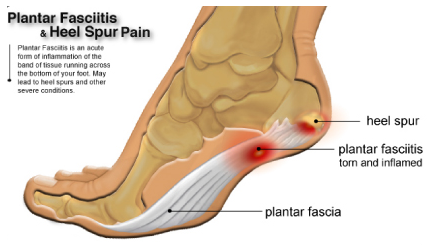Western Epidemic
#GERD#Hyperglycemia#LIPH#Fasting#HyaluronicAcid #Collagen #LiverGallbladderCleanse #Hemp #Stress #BrainAge #Drugs #EndocrineDisruptiors #Hypertension#Microplastics #WaterSmarts #ToxicChemicals #LiverHealth #MilkThrisle #Magnesium #LiverCleanse #MedicinalMushroomsForAtheleticPerformance #BrainBoostingMedicinalMushrooms #RoyalColloids #CalciumDGlucarate #ProteinMalfunction #MedicinalMushrooms #JapaneseLongevitySecret #PlantarFasciitis #BlackCuminTheBlackGold #ThroatThyroidEsophagusLarynx#BasicBiohacks#SkinHealth#VariousLipids #Radiation #LungHealth #Sinkholes #Praying #HepatitisC #ImmuneBoostingFoods #ImmuneBoostingSupplements #ImmuneBoostingBiohacks #BetaGlucans #BetaGlucanKids #Phytoplankton
Overview
Plantar fasciitis (PLAN-tur fas-e-I-tis) is one of the most common causes of heel pain. It involves inflammation of a thick band of tissue that runs across the bottom of your foot and connects your heel bone to your toes (plantar fascia).
Plantar fasciitis commonly causes stabbing pain that usually occurs with your first steps in the morning. As you get up and move more, the pain normally decreases, but it might return after long periods of standing or after rising from sitting.
Symptoms
The pain is usually worse after exercise, not during it. Pain caused by plantar fasciitis, generally improves with walking and increases after exercise and periods of inactivity. A high arch and difficulty flexing the foot are common signs of plantar fasciitis.
Heel (calcaneal) spurs are calcium deposits that grow on the bottom of the heel bone, and they can grow as much as a half inch. Heel spurs only cause pain in one in 20 people. It is possible for a person to have both plantar fasciitis and heel spurs.
Heel spur pain generally comes from plantar fasciitis, or irritation of the plantar fascia (the tissue band that runs along the bottom of the foot, supporting the ball), and treatment involves options ranging from ice and rest, to orthotic inserts and physical therapy. Surgery is quite rare
Heel pain that is at its worst in the morning is likely plantar fasciitis, while pain while walking or standing may be caused by heel spurs
Causes
Your plantar fascia acts like a shock-absorbing bowstring, supporting the arch in your foot. If tension and stress on that bowstring become too great, small tears can arise in the fascia. Repetitive stretching and tearing can cause the fascia to become irritated or inflamed, though in many cases of plantar fasciitis, the cause isn’t clear.
Though plantar fasciitis can arise without an obvious cause, factors that can increase your risk of developing plantar fasciitis include:
- Diabetes – Diabetes may cause pain in the heel and the rest of the foot through neuropathy, or nerve damage, due to chronically high levels of blood sugar. Neuropathy is a common side effect of diabetes, but the pain it causes is not typically strong
- Age – Plantar fasciitis is most common between the ages of 40 and 60.
- Certain types of exercise – Activities that place a lot of stress on your heel and attached tissue — such as long-distance running, ballistic jumping activities, tennis, martial arts, ballet dancing and aerobics — can contribute to an earlier onset of plantar fasciitis.
- Foot mechanics – Being flat-footed, having a high arch or even having an abnormal pattern of walking can affect the way weight is distributed when you’re standing and put added stress on the plantar fascia.
- Obesity – Excess pounds put extra stress on your plantar fascia.
- Occupations that keep you on your feet – Factory workers, teachers and others who spend most of their work hours walking or standing on hard surfaces can damage their plantar fascia.
Complications
Ignoring plantar fasciitis may result in chronic heel pain and heal spurs, that hinders your regular activities. Changing the way you walk to minimize plantar fasciitis pain might lead to foot, knee, hip or back problems.
Treatment & Prevention
In most cases, plantar fasciitis and heel spurs can be treated without surgery. Common treatment options include rest, stretches, ice, anti-inflammatory medication and cortisone injections. Treatment options for heel spurs include rest, properly fitted shoes and using a cut-out heel pad
# 1 Insoles
# 2 Stretching and Massaging
First thing in the morning, before your first step on the floor, do flex/extend toes (30 reps each), flex/extend the heal (30 reps), then do this stretches (10 sec hold each) then the massage from same video
Massaging with Icy bottle 2-3 times a day is crucial for speedy recovery – massages & Icing at the same time!
#3 Shoes
Top Running Shoes for Plantar Fascia, Dress Shoes for Plantar Fascia My ultimate choice for tennis shoes is Adidas Barricade Classic
#4 Taping
Supporting your heal and foot with athletic tape is highly beneficial for healing and recovery
#5 Bracing and Splinting
#6 Plantar Fascia Sleeve
#7 Plantar Fascia Pads
#8 Plantar Ice Wrap
#9 Supplements
Collagen, Hyularonic Acid, Magnesium, Turmeric
#10 Diet
Beneficial
The following foods are anti-inflammatory powerhouses
- Spinach: Spinach is high in both vitamin C, calcium, magnesium, and MSM.
- Oranges: Oranges are high in calcium, MSM, and vitamin C.
- Pumpkin seeds: Pumpkin seeds are high in calcium and vitamin C
- White beans: White beans are high in calcium and magnesium
Avoid
Just as some foods can decrease the pain and inflammation, others can spike it up – avoid at no cost if you don’t want to live your life miserably in chronic pain:
- Sugar: Sugar is a prime culprit for increasing irritation and inflammation in body tissues.
- Processed grains: Refined grains (for example, bleached white flour) can also increase inflammation.
- Saturated fat and trans fats: This is the type of fat you’ll find in many processed junk food and treats, as well as processed meats like hot dogs and pepperoni. Like sugar and processed grains, they’re prime culprits for inflammation.
NOTE: Ladies, wearing high heels on a regular basis or at least once a week is highly beneficial to strengthen the ligament and prevent future damage
Pain Is NOT a Lifestyle
NOAGENATION.COM

